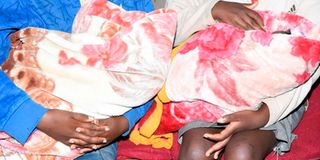Holistic approach needed to curb teen pregnancies, HIV infections

Twins aged 14 years old, who are in standard seven at a primary school in Ng’enyilel, Turbo of Uasin Gishu County, cuddle their children aged two days old and six days old respectively, at their home on September 01, 2021.
What you need to know:
- One in every Kenyan girl aged between 10 and 19 is either pregnant or has given birth to her first child.
- Alcohol and drug abuse are also exposing young people to HIV infection, teen pregnancy and SGBV.
Kenya has a predominantly young population, with 67 per cent aged below 29 years. Teenage girls continue to face the triple threat of violation, pregnancy and HIV infections, going by data from the National Council for Population and Development (NCPD) and the Ministry of Health.
Kenya has a high burden of teenage pregnancy and teen motherhood, and one in every Kenyan girl aged between 10 and 19 is either pregnant or has given birth to her first child. The prevalence has not changed much since 2008.
Between January and February 2022, Kenya recorded 45,724 cases of pregnancies among teens aged between 10 and 19. This alongside 2,196 cases of sexual and gender-based violence (SGBV) among those aged 12 to 17 years, with 98 girls aged between 10 and 19 years having been infected with HIV due to SGBV.
The same age group recorded high unmet contraception needs at 23 per cent, against a national average of 18 per cent, and with more than 60 per cent not using any contraception method.
Adolescent mothers
In 2021, the Ministry of Health recorded 12,520 cases of SGBV and was able to offer HIV preventive services to 4,664 young survivors. Unfortunately, 53 of the survivors had contracted HIV.
In the same year, of all the antenatal care attendances, 21 per cent were adolescent mothers aged 10-19, compared to 2018, where 427,135 cases of teen pregnancies were reported at antenatal clinics. Although the numbers were still high, they had reduced by 26 per cent to 317,644. A total of 23,279 girls aged 10 and 14 were recorded as pregnant. Between 2013 and 2021, HIV programmes yielded a 67 per cent decline in annual Aids-related deaths.
Again, an increasing number of young people are injecting themselves with narcotic drugs, at a time when more than 8,000 people are on opioid substitution therapy. These young people are at high risk of contracting HIV and Hepatitis infections.
Alcohol and drug abuse are also exposing young people to HIV infection, teen pregnancy and SGBV.
Preventive strategy
The war on early pregnancies, HIV/Aids and drugs among teens requires a preventive lens through a one-government approach. A holistic and inclusive preventive strategy would also help reintegrate affected girls back to school.
The ministries of Health and Gender, the National Police Service, Office of the Director of Public Prosecutions, Court Users Committee, local administration and the civil society should ensure young people are protected from discrimination, stigma and violence and that perpetrators of teenage pregnancies and GBV face the law.
The National Aids Control Council, through its county officers, should take advantage of Interior and National Coordination field activities such as community policing, community peace and security committees, as well as disaster relief coordination mechanisms to create awareness on HIV/Aids, teen pregnancy and SGBV.
Mr Wendo is the founder, Integrated Development Network; [email protected]





